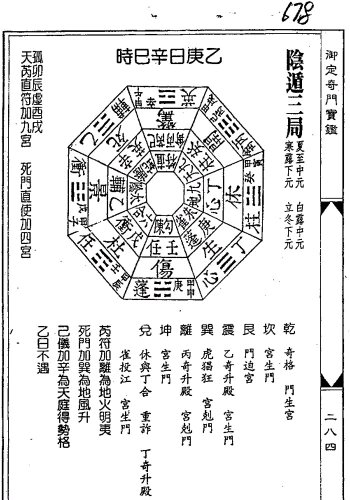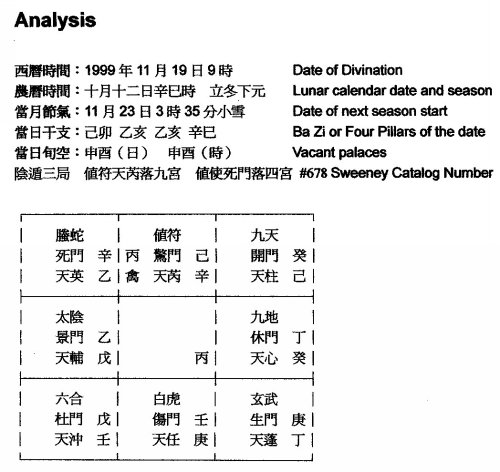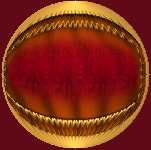Chinese Or Western Medicine?
Medical Qi Men Dun Jia: A method for determining which
type will prove effective in healing
(c)Jack Sweeney 2007
One dilemma faced by practitioners of Chinese medicine
comes in deciding whether Chinese medicine or Western
medicine would more readily cure a specific ailment
and thus benefit the client. The borderline between
Chinese and western medicine is fairly nebulous, with
no clear demarcation. Most practitioners must build up
years of experience before coming to know when to
refer clients to western doctors, and when to continue
with Chinese medicine.
The reverse is seldom true. Most doctors of western
medicine persist with western medicine until the end,
often at great cost in time and money to patients.
Only after western medicine has failed to cure a
disease, often after a long and expensive medical
journey, will a patient decide for herself that
Chinese medicine might prove more efficacious than
western medicine. In rare cases, doctors of western
medicine will suggest Chinese medicine, usually only
after they have thrown in the towel.
There is a simpler, easier and far less expensive way.
Medical divination by Qi Men Dun Jia, the ancient
Chinese style of imperial divination may help
practitioners decide whether Chinese or western
medicine can more readily cure disease. A
straightforward medical divination can reveal within
minutes whether Chinese or western medicine would
prove more effective, or whether both would prove
effective or ineffective, in any particular medical
case.
Introduction
Qi Men Dun Jia is an ancient Chinese form of
divination based on the Yi Jing (I Ching), China’s
traditional lunar calendar, and the doctrines of Yin
and Yang and the Five Elements (Five Phases). A series
of symbols is imposed on a 3 x 3 magic square, and the
symbols are rotated around the magic square every two
hours, in accord with the double – hour of the
traditional Chinese lunar calendar. The symbols are
arranged in four levels which correspond to Heaven,
Spirit, Earth, and Humanity, and rotate from square to
square (or palace to palace, as per Qi Men Dun Jia
terminology).
In medical divination, the Qi Men Dun Jia analyst
devises a “situation” based upon the time of day that
a client poses a question about a medical condition.
The analyst calculates the positions of the symbols
during the particular double – hour when the question
is posed, and then conducts analysis of the symbols to
investigate the medical condition of the person in
question.
Qi Men Dun Jia is relies on the selection of certain
symbols to represent particular aspects of disease. In
general, the Tian Rui Star denotes the disease, while
the Heavenly Stem Yi represents Chinese medicine and
doctors who practice Chinese medicine. The Tian Xin
Star represents western medicine and doctors who
practice western medicine. The palaces and other
symbols represents parts of the body, blood and
fluids, as well as temporal aspects that influence
healing, recovery, or worsening of disease conditions
and death.
Analysis of Five Element relationships leads to
conclusions about the condition of the person. Each
palace pertains to one of the Five Elements – Water,
Earth, Wood, Fire or Metal – and when the Use Spirits
fall into those palaces, they are governed by that
element. The analyst reviews the engender and curtail
relations between the elements. When Yi or the Tian
Xin Star curtail the Tian Rui Star, this indicates
that Chinese or western medicine or doctors would
prove efficacious in healing a specific ailment. When
one or the other, or neither, fails to curtail the
Tian Rui Star, then a given treatment would prove
ineffective against disease.
The analyst constructs a series of conclusions about
the person’s condition to build a logical argument
that leads to a concrete determination. For example, a
series of symbols may indicate a problem in the head,
which is associated with blood, and that includes a
blockage of some sort. The analyst may then draw a
tentative conclusion that the person suffers from a
blocked blood vessel in the head.
Additional interpretation of symbols may lead to
similar conclusions, and in this way, a logical case
is constructed, based on a series of solidly –
reasoned conclusions. Ideally, the symbols present a
medical story that unfolds with clear logic and no
contradictions. If contradictions are encountered,
these should be met and analyzed until the argument
appears flawless, and the actual medical condition
revealed.
As an example of how Qi Men Dun Jia analysis works in
practice, this paper provides an example that was
originally written by a Chinese Qi Men Dun Jia
analyst, Mr. Shi Jianguo. The case was originally
published in Chinese and has been translated into
English by the author of the present paper. The
original work has been completely translated, and
there is no additional information about the case
available.
Divination of Cancer of the Digestive Tract
Shi Jianguo was working in the office of the Zhou Yi
(I Ching) Research Association in Shi Jia Zhuang city,
Henan Province, China, on 19 November 1999 at 09:30
when he received a telephone call from Mr. Zhang
Fengming, of Shi Jia Zhuang city. Mr. Zhang requested
a medical divination for his father, who was born in
1929. Shi Jianguo requested that Mr. Zhang wait for
fifteen minutes before calling him back. In the
meantime, Mr. Shi devised a Qi Men Dun Jia situation
on a piece of paper and then conducted analysis of the
medical condition of Mr. Zhang’s father. When Mr.
Zhang called back, Mr. Shi told him the following.
“Your father has a disease of his digestive system,
specifically, he has cancer of the tract that carries
his food, and his condition is comparatively serious.”
“Master Shi, you have divined quite accurately. The
doctors have examined my father and found that he does
indeed suffer from cancer of the digestive tract. They
have found malignant tumors.”
“There’s more bad news. Neither western medicine nor
Chinese medicine can save your father now. At best,
Chinese medicine may help relieve your father’s pain
along the way. He will survive this year, but will run
into great danger during the third lunar month of next
year.”
Later, Zhang Fengming informed Shi Jianguo that his
father had died on the 27th of the third lunar month,
which was a Ji Wei date, or 1 May 2000.
Analysis


1. How to determine that the patient will die? The Zhi
Shi represents the subject matter of the divination,
and here Death Gate indicates that this story concerns
the death of Mr. Zhang’s father. When a trigram meets
Five Do Not Meet, then the person will soon die. The
Tian Rui Star falls into Li Palace 9. The structured
situation of Ji Added Xing (Wandering Soul Enters the
Grave) means that malevolent departed souls are
causing trouble in the dimension or realm of the
deceased. The structured situation of Bing Added Xing
unites Bing and Xing. In divination of disease, unity
of two symbols is most feared, since this indicates
that the disease will prove difficult to cure.
These symbols fall near Fear Gate, an added negative,
and Fear Gate Added View Gate hosts a negative turn
for disease. While these symbols ride the positive
symbol of the Zhi Fu, the positive aspect is cancelled
by the great negatives wrought by the structured
situation. The Zhi Fu remains unprotected, and when
the Zhi Fu lies unprotected, lives fall into danger.
From another perspective, the Zhi Fu represents the
head, so this may indicate the process of a serious
disease reaching its climax, with the most dangerous
period in view.
2. How to determine that the disease lies in the
digestive tract? The Hour Stem may represent the
disease, and here Xing falls into Xun 4 to ride Flying
Snake. Xun is associated with the digestive tract, as
is Flying Snake. These symbols encounter Death Gate
which implies obstacles and blockages. The Tian Ying
Star is associated with Fire and Fire indicates
inflammation. The structured situation of Xing Added
Yi carries the meaning of the White Tiger Goes Wild,
which brings bankruptcy and loss of human life. Xing
falls into Xun 4 in the condition of Entering the Chen
Grave, a large negative. This rides Flying Snake,
which symbolizes entwined, complex affairs, so the
disease will prove difficult to cure.
3. The Zhi Shi gate symbolizes the matter to hand, and
here Death Gate falls into the same palace as the Hour
Stem. These have been explained above.
4. How to confirm that the disease is cancer of the
digestive tract? Wound Gate may be selected as the Use
Spirit to represent the disease, and here Wound Gate
falls into Kan 1, near Ren Water, which hosts the
digestive tract. These fall near Geng, which
represents obstructions, and ride White Tiger, host of
wounds and loss. Kan Water engenders Wound Gate and
when a negative gate is engendered, that increases the
negativity of the gate. Taken together, all of the
symbols indicate cancer of the digestive tract.
5. How to determine whether Chinese or medicine would
cure the disease? Yi Qi falls into Zhen 3 (Wood) where
Chinese medicine fails to curtail the disease in its
palace. The Tian Xin Star represents western medicine
and falls into Dui 7 (Metal) and fails to curtail the
Tian Rui Star (the disease) in its palace (Fire).
Thus, neither Chinese nor western medicine will prove
capable of curing the disease. Taking the analysis one
step further, the Tian Xin Star falls into palace to
meet a vacancy, which indicates that western curative
methods would prove completely ineffective in this
instance. For this reason, Shi Jianguo advised Mr.
Zhang to have doctors provide Chinese medicine for his
father to minimize the effects of his cancer, even as
he headed toward death.
6. How to determine when the patient will die? Why
would Mr. Zhang’s father face a health crisis during
the third lunar month of 2001? There are a variety of
ways to calculate the Determinant Period in Qi Men Dun
Jia, or the period of time until a certain action
takes place, such as when a person leaves hospital,
recovers from or dies of disease.
The first method is that when a Use Spirit meets the
condition of “flooding,” then the period of time until
that flooding becomes the Determinant Period. Mr.
Zhang’s father was born during a Ji Si year, and his
Year Fate Ji falls into Li 9. In that position, Ji
curtails Great Age of the following year, 2000,
represented by Geng, in its palace (Fire of Li 9
curtails Metal in Qian 6). The third lunar month of
2000 was a Geng Chen month, which was also the month
represented by Great Age (Geng). In addition, Jia Xu
Ji floods and curtails Geng Chen month, which is the
third lunar month. In Qi Men Dun Jia analysis, when
Great Age is curtailed, then a disaster ensues.
The period of time until the Use Spirit Enters Grave
may be calculated as the Determinant Period. Here, the
Hour Stem Xing falls into Xun 4 in the condition of
Enter Grave. The third lunar month is Chen month, and
when Chen month Enters Grave, then the patient must
die. Death Gate is the Zhi Shi and also falls into Xun
4, and during the third lunar month when Chen month
Enters Grave, the patient must die.
Where the Hour Stem and the Zhi Shi fall into palace
may be calculated as the Determinant Period. Here, the
Hour Stem Xing and the Zhi Shi, Death Gate, both fall
into Xun 4. Xun palace carries the numerical
connotations of four and five, so I selected five.
During the Yin Dun half of the year, Xun falls into
the external pan, which hosts slow and distant
movement. Thus, the patient’s remaining lifetime would
be measured in months and in years. Adding the
information together, Shi Jianguo surmised that the
patient would die within five months.
Discussion
Part Five above illustrates how to determine whether
Chinese or Western medicine will prove effective in
curing disease and healing ills. In this particular
instance, neither Chinese nor Western medicine proved
capable of healing the patient. Moreover, Western
treatments proved less effective than Chinese medicine
in helping deal with the effects of the disease as
much as possible. To be sure, not every medical
divination in Qi Men Dun Jia has the same outcome. At
times western medicine proves effective, at times
Chinese, at times neither.
While the mastery of Qi Men Dun Jia requires some
effort and investment of time, the payoff can prove
quite rewarding. Rather than waste money, time and
effort in unnecessary and futile healing regimes,
practitioners might know ahead of time whether their
efforts would help patients. With this particular
aspect of Qi Men Dun Jia medical divination,
practitioners would know whether Chinese medicine
would prove effective in helping patients, or whether
western medicine would prove more likely to help.
If widely adopted by practitioners of Chinese
medicine, Qi Men Dun Jia medical divination would help
make Chinese medicine more efficient and cost –
effective versus western medicine. Moreover, Qi Men
Dun Jia medical divination might raise the public
stature of Chinese medicine. Many times, the key to
victory is the ability to choose which battles one
will fight. If practitioners of Chinese medicine know
in advance which battles they might win and which they
would lose, the obvious course would be to choose
victory. In those instances where Chinese medicine
might fail patients, it would perhaps serve the best
interests of all concerned to say so at the start of
treatment, rather than after a costly string of
defeats.
References
Advanced Medical Divination with Qi Men Dun Jia, by
Jack Sweeney, Wuhan, Hubei, China. Yan Bo Publishing
Company, 2007.
Shi, Jianguo, Qi Men Dun Jia Zui Xin Shi Lie Jie Xi,
Hong Kong: Jian Zhu yu Feng Shui Za Zhi She, 2006.
Xu Daofu, Yu Ding Qi Men Bao Jian (Xiu Ding Ben)
Taipei: Wuling Chu Ban She, 2004.

















